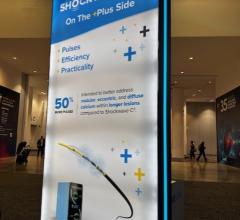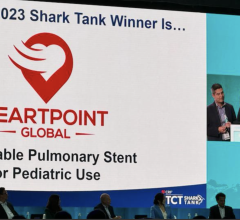
BIO-RESORT: TLF at five years
July 5, 2022 — A BIO-RESORT subgroup analysis of outcomes in small coronary vessels (<2,5mm) evaluated the efficacy and safety of three contemporary DES including BIOTRONIK’s ultrathin struts drug-eluting stent (DES) Orsiro at 5 years. The results of the analysis were presented by Dr. Eline H. Ploumen, Thoraxcentrum Twente, Medisch Spectrum Twente, Enschede, The Netherlands, at the EuroPCR conference in May.
Patients with smaller coronary target vessels are usually associated with a higher risk of Target Lesion Revascularization (TLR) following percutaneous coronary intervention (PCI)1. In this context, the BIO-RESORT subgroup analysis aimed to assess whether thinner struts lead to a lower adverse event risk and better patient outcomes. The randomized trial analyzed the five-year outcomes of coronary artery disease patients treated with three contemporary DES of varying strut-thickness – ultrathin (Orsiro), very thin (Synergy) and thin (Resolute Integrity) strut drug-eluting stents.2
"Although we have not seen a statistically significant difference in five-year target lesion failure rate, our subgroup-analysis shows a trend towards better outcomes with thinner strut DES for patients with small vessels", commented Dr. Eline H. Ploumen on the results. "While percutaneous coronary intervention of small vessel lesions remains challenging, thinner strut DES are a good choice for the treatment of these lesions."
Key findings:
Although patients treated with Orsiro DES were more often treated for a complex target lesion than patients with other DES (71.4% for Orsiro vs. 68.7% for Synergy and 63.3% for Resolute Integrity), results show favorable outcomes for BIOTRONIK’s ultrathin strut DES.
Target lesion failure (TLF) for Orsiro DES remains numerically lower at 5 years (10.5% for Orsiro vs. 11.1% for Synergy and 12.6% for Resolute Integrity).
Target lesion revascularization (TLR) for Orsiro DES remains numerically lower at 5 years (4.4% for Orsiro vs. 4.7% for Synergy and 6.8%% for Resolute Integrity).
Definite or probable stent thrombosis rate remains numerically lower for Orsiro DES at 5 years (1.0% for Orsiro vs. 1.7% for Synergy and 2.0% for Resolute Integrity).
"These new BIO-RESORT data support the benefits of our outstanding Orsiro DES design", noted Dr. Alexander Uhl, President Vascular Intervention at BIOTRONIK. "Small vessels are a particularly challenging lesion type to treat and with Orsiro the data indicates we can achieve an incremental improvement in patient outcomes."
The BIO-RESORT non-inferiority study included 3,514 all-comer patients and was designed to assess two biodegradable polymer stents against a durable polymer reference device in all-comers patients. At one-year, non-inferiority was established for Orsiro and Synergy against Resolute Integrity DES3. Last year, full-cohort five-year outcomes from the BIO-RESORT trial were presented at the Transcatheter Cardiovascular Therapeutics (TCT) conference.4
References:
1. Wykrzykowska J. J. et al.: Impact of vessel size on angiographic and clinical outcomes of revascularization with biolimus-eluting stent with biodegradable polymer and sirolimus-eluting stent with durable polymer: The LEADERS trial substudy. JACC Cardiovasc Interv. 2009 Sep;2(9):861-70.
2. Strut thickness: Orsiro 60 μm, Synergy 74 μm and Resolute Integrity 91 μm.
3. von Birgelen C. et al.: Very thin strut biodegradable polymer everolimus-eluting and sirolimus-eluting stents versus durable polymer zotarolimus-eluting stents in allcomers with coronary artery disease (BIO-RESORT): a three-arm, randomised, non-inferiority trial, The Lancet, 2016 Nov 26;388(10060):2607-17.
4. Ploumen E.H., BIO-RESORT : 5 Year outcomes from a randomized trial of 3 drug- eluting stents in patients with coronary artery disease, presented at TCT 2021.
Orsiro is a trademark or registered trademark of the BIOTRONIK Group of Companies. All other brands are trademarks are the property of their respective owners.
For more information: https://en.orsiro.com/
Related Stent Content:
New Directions and Trends in Coronary Metallic Stents
Biotronik's Orsiro Drug-Eluting Stent Outperforms Xience in BIOFLOW-V Trial
Orsiro Stent Performs in Two Comparison Studies Presented at TCT 2018
Orsiro DES Shows Lowest Two-Year Target Lesion Failure in BIO-RESORT Trial
Orsiro Demonstrates Benefit over Xience in Heart Attack Subgroup
Biotronik Orsiro DES Shows Low Five-Year Event Rates
Biotronik Orsiro Hybrid Drug-Eluting Stent Lives up to Abbott’s Xience Prime Standards
VIDEO: The Current State of Bioresorbable Stents in 2018 — Interview with Patrick Serruys, M.D.
VIDEO: Cath Lab of the Future Cardiovascular Technologies to Watch — Interview with Juan Granada, M.D.


 May 05, 2025
May 05, 2025 








